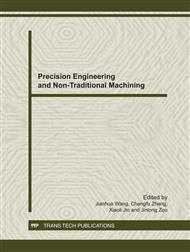p.140
p.144
p.149
p.158
p.163
p.169
p.174
p.179
p.183
Research of Tool Wear Monitoring Based on Hurst Exponent Extraction of Cutting Surface Texture
Abstract:
A new approach using Hurst exponent extracted from the texture of cutting surface was proposed to characterize the nature of the observable long-term-memory power system function of cutting process. Hurst exponent extraction algorithm was given. The cutting images were gotten from the experiment of tool wear monitoring system. Then the Hurst exponent is extracted from the images during the cutting process. Experiments show that the reduction of Hurst exponent reflected the tool wear process and the Hurst exponent can be a monitoring feature.
Info:
Periodical:
Pages:
163-166
Citation:
Online since:
November 2011
Authors:
Keywords:
Price:
Сopyright:
© 2012 Trans Tech Publications Ltd. All Rights Reserved
Share:
Citation:


